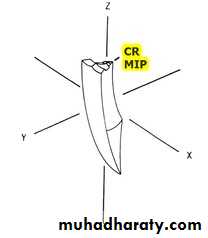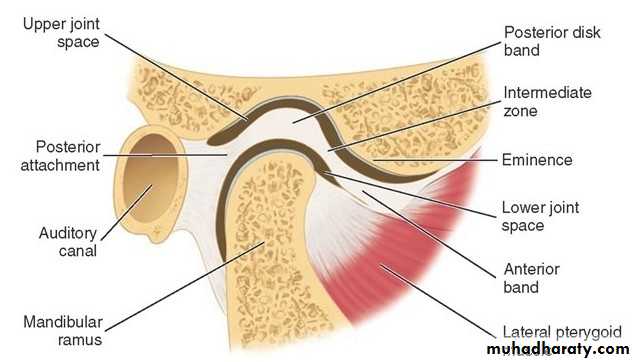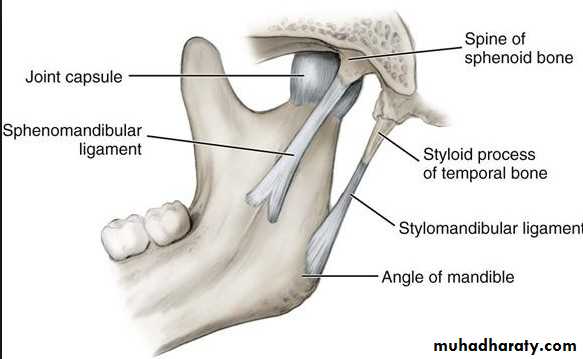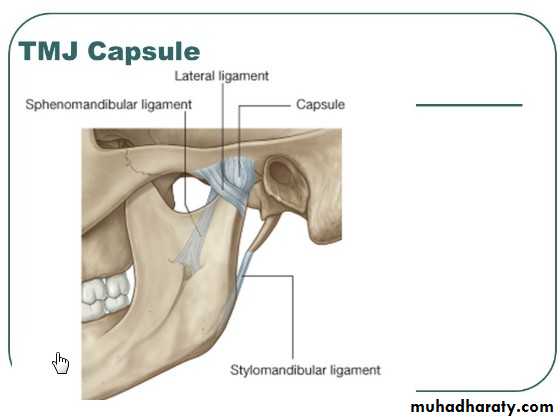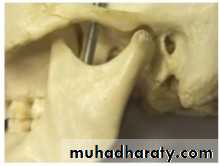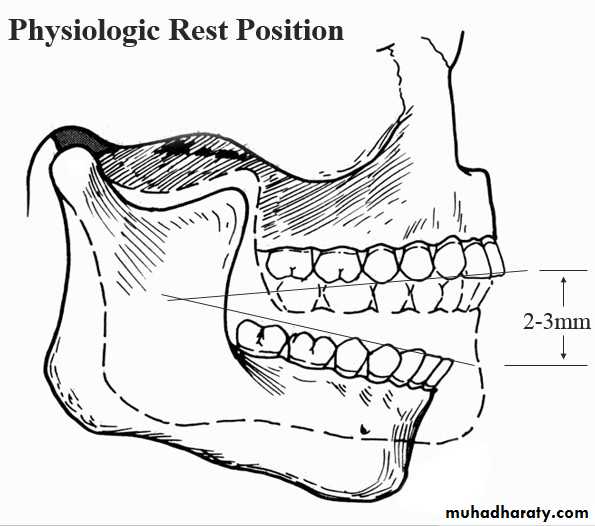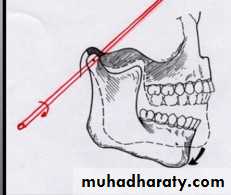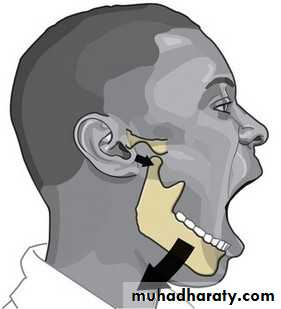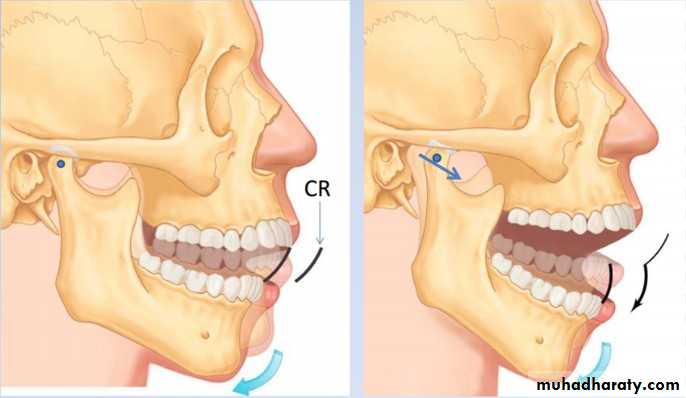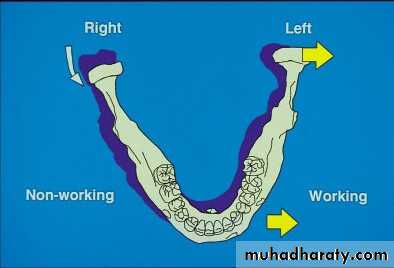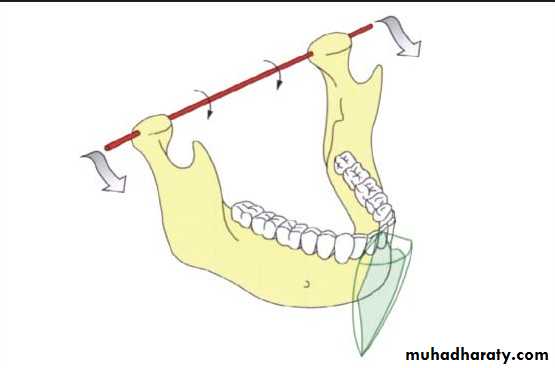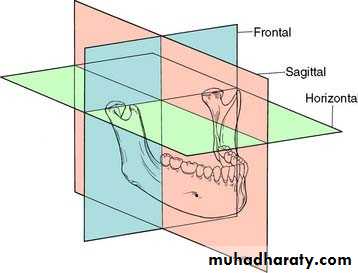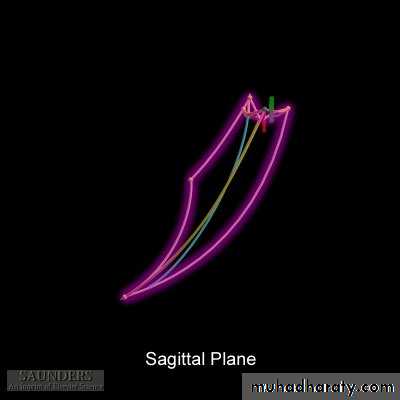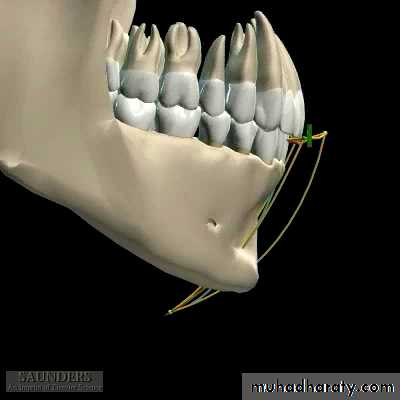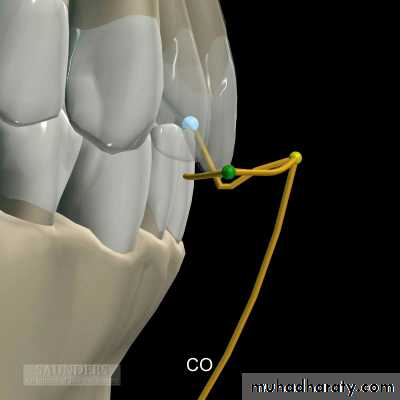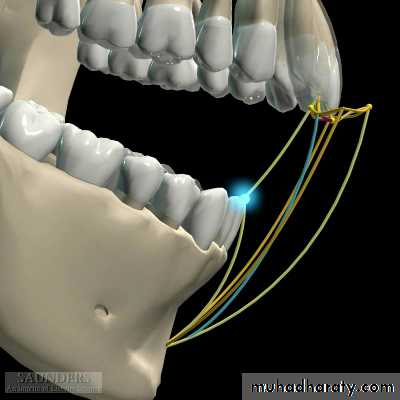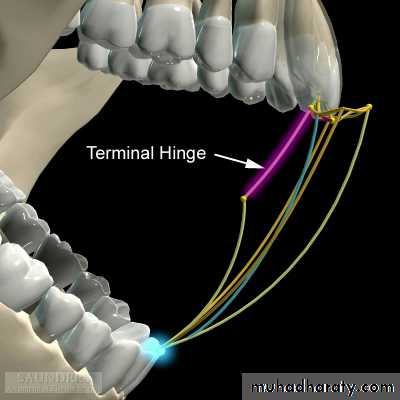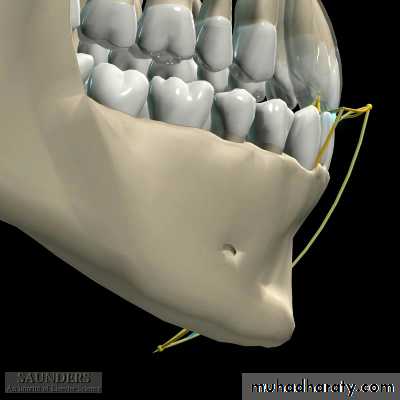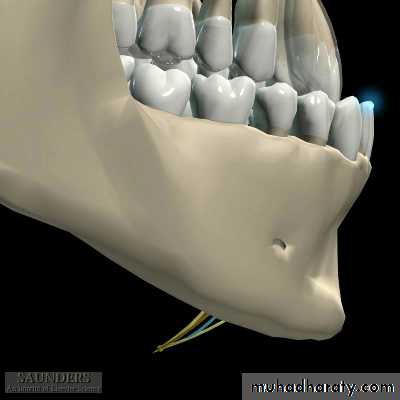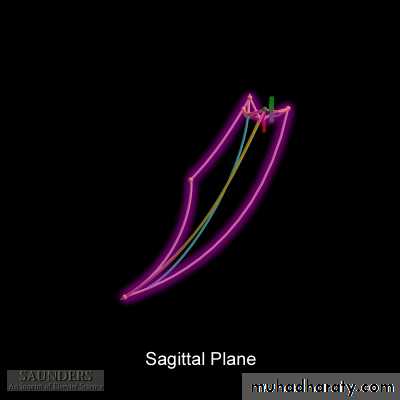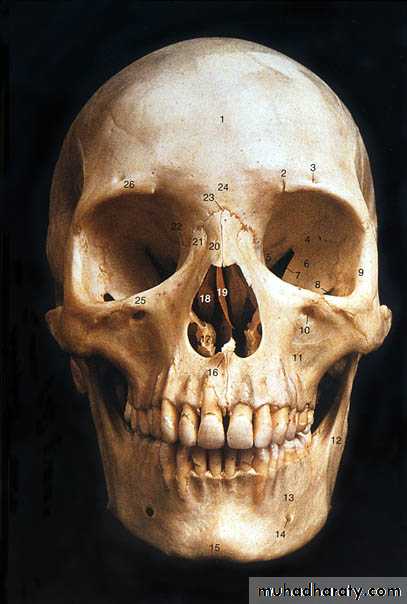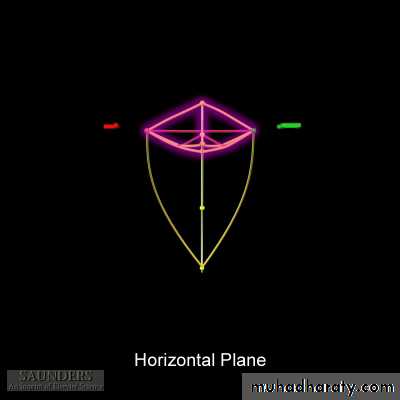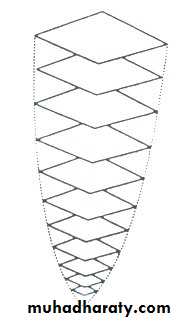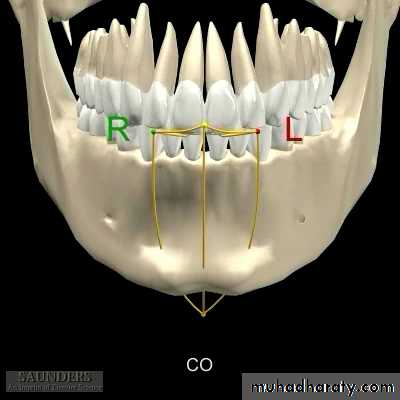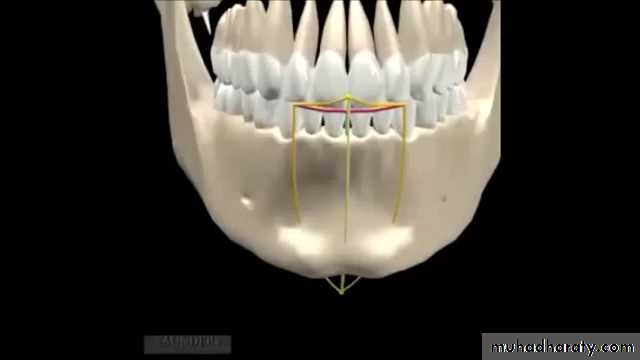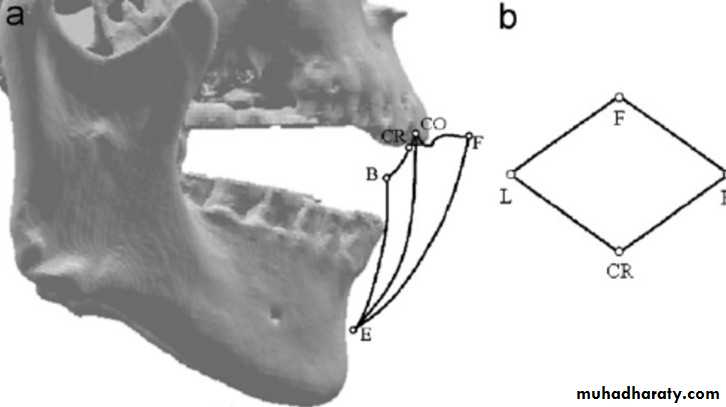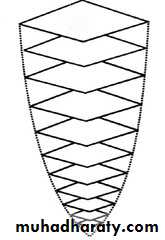Tmj anatomy ,physiology, mandibular movements
Lec. 1By
Asst.Prof.Dr.Radhwan Himmadi Hasan
B.D.S , M.Sc. , Ph.D. Prosthodontics
Asst.Prof.Dr.Radhwan Himmadi Hasan 2019
1
Envelope of Motion
Dr ulf posselt’s in 1952 first described a 3D concept of mandibular movementsIt was a Combination of border movements in all 3 planes:
a) Sagittal
b) Horizontal
c) Frontal
The envelope differs from person to
person but it has the same
characteristic shape
Asst.Prof.Dr.Radhwan Himmadi Hasan 2019
2
Envelope of Motion
The superior surface of the envelope is determined by the tooth contactsThe other borders are primarily determined by the TMJ anatomy and the ligaments
Asst.Prof.Dr.Radhwan Himmadi Hasan 20193
What is temporomandibular joint??
It is the area where the mandible articulates with the cranium.It is described as a complex , multiaxial ,synovial , condylar and ginglimoarthroidal joint.
Tmj is also known as CRANIOMANDIBULAR JOINT.
Asst.Prof.Dr.Radhwan Himmadi Hasan 2019
4
Asst.Prof.Dr.Radhwan Himmadi Hasan 2019
5Cranial component
It is also known as mandibular/glenoid fossa.
• Mandibular component
The articular part of the mandible is an Ovoid condylar process.• Tmj capsule
It is a thin sleeve fibrous tissue investingjoint completely.
Inside fibrous tissue capsule, a synovial
membrane is present.Asst.Prof.Dr.Radhwan Himmadi Hasan 2019
6Ligaments:
Following are the ligaments associated with TEMPOROMANDIBULAR JOINT• The lateral or temporomandibular ligament
• Sphenomandibular ligament
• Stylomandibular ligament
Asst.Prof.Dr.Radhwan Himmadi Hasan 2019
7Asst.Prof.Dr.Radhwan Himmadi Hasan 2019
8Asst.Prof.Dr.Radhwan Himmadi Hasan 2019
9Reference Positions
Centric RelationMaximum Intercuspal Position
Postural Position – resting positionAsst.Prof.Dr.Radhwan Himmadi Hasan 2019
10Centric Relation
The position of the mandible in which the condyles are in the most superior and anterior position in the articular fossae, resting against the posterior slopes of the articular eminences with the articular discs interposed.Condyle determined position
Repeatable, Reproducible,
Recordable
Asst.Prof.Dr.Radhwan Himmadi Hasan 2019
11Maximal Intercuspal Positionor Maximum Intercuspation
This is a position in which the maxillary and mandibular teeth make maximum surface contact with each other. The mandible is elevated as superiorly as possible in the sagittal plane.Tooth determined position
Does not provide any information about the TMJ
In most people, MIP does not
coincide with CR
Asst.Prof.Dr.Radhwan Himmadi Hasan 2019
12Postural Position (PP)
Is the habitual position of the mandible when the patient is resting comfortably in the upright position and the condyles are in a neutral unstrained position in the glenoid fossae.In this position there is an equilibrium between the forces acting on the mandible.
This position is determined by the muscles and the forces of gravity.
Asst.Prof.Dr.Radhwan Himmadi Hasan 2019
13
Postural Position
In this position, the teeth are apart and there is a wedge space between the teeth.The wedge shaped space is called the INTEROCCLUSAL SPACE and is usually 2-3mm between the incisors, 2mm between the premolars, and 0.75-1mm between the molars.
Asst.Prof.Dr.Radhwan Himmadi Hasan 2019
14Asst.Prof.Dr.Radhwan Himmadi Hasan 2019
15Asst.Prof.Dr.Radhwan Himmadi Hasan 2019
16Asst.Prof.Dr.Radhwan Himmadi Hasan 2019
17Asst.Prof.Dr.Radhwan Himmadi Hasan 2019
18Asst.Prof.Dr.Radhwan Himmadi Hasan 2019
19Asst.Prof.Dr.Radhwan Himmadi Hasan 2019
20Asst.Prof.Dr.Radhwan Himmadi Hasan 2019
21
As In CR condyle will be against avascular part of the articular disk in TMJ
Asst.Prof.Dr.Radhwan Himmadi Hasan 201922
Asst.Prof.Dr.Radhwan Himmadi Hasan 2019
23Asst.Prof.Dr.Radhwan Himmadi Hasan 2019
24Asst.Prof.Dr.Radhwan Himmadi Hasan 2019
25
Asst.Prof.Dr.Radhwan Himmadi Hasan 2019
26Asst.Prof.Dr.Radhwan Himmadi Hasan 2019
27Asst.Prof.Dr.Radhwan Himmadi Hasan 2019
28Asst.Prof.Dr.Radhwan Himmadi Hasan 2019
29Asst.Prof.Dr.Radhwan Himmadi Hasan 2019
30three Basic Types of Movement
1-Hinge movement• When the mandible is in centric relation the condyles can rotate around a horizontal axis up to an opening of 20-25 mm measured at the central incisors.
Asst.Prof.Dr.Radhwan Himmadi Hasan 2019
31
Asst.Prof.Dr.Radhwan Himmadi Hasan 2019
322-Translatory movement
• If opening of the mandible continues beyond 20-25 mm then translation of the mandible occurs.Asst.Prof.Dr.Radhwan Himmadi Hasan 2019
33Asst.Prof.Dr.Radhwan Himmadi Hasan 2019
343-Lateral movements(right and left direction)
• The side to which the mandible is moving is called the WORKING SIDE• The side that is opposite to the working side is called BALANCING OR NON WORKING SIDE
3) The condyle on the working side is called the WORKING OR ROTATING CONDYLE
4) The non-working condyle is called THE BALANCING OR THE ORBITING CONDYLE
Asst.Prof.Dr.Radhwan Himmadi Hasan 201935
Border Movements
The mandibular movements are limited by ligaments, the articular surfaces of the TMJ, and the morphology of the teeth. The outer range of movement is reproducible and called border movements.Asst.Prof.Dr.Radhwan Himmadi Hasan 2019
36
Three-dimensional description of the Mandibular & Maxillary positioning
Also known as Axes of RotationReference Planes
Asst.Prof.Dr.Radhwan Himmadi Hasan 201937
Reference Planes
Sagittal PlaneAlso known as a side view.
Asst.Prof.Dr.Radhwan Himmadi Hasan 2019
38Reference Planes
Sagittal AxisAsst.Prof.Dr.Radhwan Himmadi Hasan 2019
39Border Movements in Sagittal Plane
Items of interest:
>Centric Relation
>Hinge axis movement
>Maximum Intercuspation
>Edge-to-edge incisal
>Maximum Protrusion
>Maximum Opening
Asst.Prof.Dr.Radhwan Himmadi Hasan 2019
40
Border Movements in Sagittal Plane
CRC (Centric Relation Contact) will see the condyles in the glenoid fossa and closure of the mandible along the hinge axis, until first tooth contact is made (many times this is in the molar region).
Asst.Prof.Dr.Radhwan Himmadi Hasan 2019
41
Border Movements in Sagittal Plane
CO (Centric Occlusion), or Maximum Intercuspation (MI), is achieved when the patient is told to get their maxillary and mandibular teeth together in a comfortable, contacting position.
Asst.Prof.Dr.Radhwan Himmadi Hasan 2019
42
Border Movements in Sagittal Plane
The mandible will open along the hinge axis, with the condyles rotating within the glenoid fossa. The rotational movement will terminate at the Terminal Hinge Axis Position.
The Terminal Hinge Axis is the rotational movement that occurs from CR to the Terminal Hinge Axis position. The condyles are rotating completely within the glenoid fossa. It is a reproducible and consistent movement.
Asst.Prof.Dr.Radhwan Himmadi Hasan 2019
43Border Movements in Sagittal Plane
Maximum Opening displays the most inferior position of the mandible, after the patient is instructed to open their mouth as wide as they can.
Asst.Prof.Dr.Radhwan Himmadi Hasan 2019
44
Border Movements in Sagittal Plane
Edge-to-Edge contact of Maxillary and Mandibular Incisors.
Mandible is protruded forward from MI, maintaining some type of tooth contact throughout.Asst.Prof.Dr.Radhwan Himmadi Hasan 2019
45
Border Movements in Sagittal Plane
Maximum Protrusion position.
The teeth are in some degree of contact (usually in Premolar-Canine area) and mandible is pushed forward as far as possible.
Asst.Prof.Dr.Radhwan Himmadi Hasan 2019
46
Border Movements in Sagittal Plane
CR
MI
E-T-E
MP
MOA
MO
HA
HAT
HA-MO
Legend:
CR = Centric RelationMI = Maximum Intercuspation
E-T-E = Edge to Edge Incisal
MP = Maximum Protrusion Point
MOA = Maximum Opening Arc
MO = Maximum Opening Point
HA-MO = Hinge Axis to Maximum
Opening
HAT = Hinge Axis Terminating
Point
HA = Hinge Axis Arc
• CL
RP
RP = Rest Position or Postural
Position of the Mandible
CL = Chewing Loop
Asst.Prof.Dr.Radhwan Himmadi Hasan 2019
47
Reference Planes
Horizontal PlaneParallel to the Occlusal Plane or the floor
Asst.Prof.Dr.Radhwan Himmadi Hasan 2019
48Horizontal Axis
Imaginary line through both condylesReference Planes
Asst.Prof.Dr.Radhwan Himmadi Hasan 2019
49Border Movements in Horizontal Plane
Characteristically described as a “diamond” shape.
Asst.Prof.Dr.Radhwan Himmadi Hasan 201950
Functional Range in Horizontal Border
As the mandible opens, the size of the horizontal plane border decreases until it reaches a “point” at the maximum opening position.
Asst.Prof.Dr.Radhwan Himmadi Hasan 2019
51
Reference Planes
Frontal PlaneBest described by facing the patient.
Asst.Prof.Dr.Radhwan Himmadi Hasan 2019
52
Frontal Axis
Reference PlanesAsst.Prof.Dr.Radhwan Himmadi Hasan 2019
53
Border Movements in Frontal Plane
Viewing the Frontal Plane is described as a “shield” diagram.
Asst.Prof.Dr.Radhwan Himmadi Hasan 201954
Border Movements in Frontal Plane
CO (Centric Occlusion). Maximum Intercuspation of the teeth.
Asst.Prof.Dr.Radhwan Himmadi Hasan 2019
55
Posselt’s envelope of motion
Asst.Prof.Dr.Radhwan Himmadi Hasan 201956

